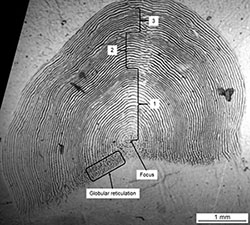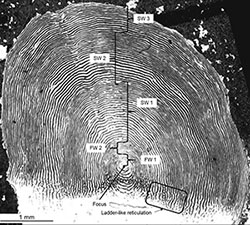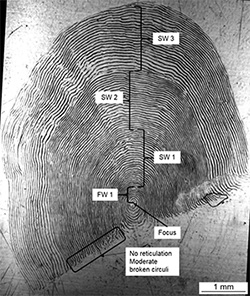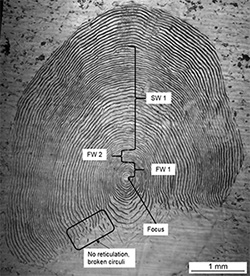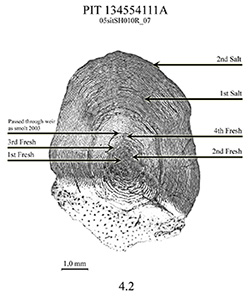Species identification
Last modified on Jan 21, 2021
Generally, salmon scales are sampled in the field by species (e.g. only chum salmon scales are collected); however, an occasional misidentification of species occurs. Thus, it is helpful to know how to identify species through scale characteristics.
Salmon life history features, such as amount of time spent in fresh versus marine waters, influence scale characteristics and can be used to identify species. Salmon life histories are described in depth by Groot and Margolis (1991), Quinn (2005), and others. Additionally, there are scale morphological characteristics that are species-specific and can be used to help identify species (Bilton et al. 1964; Mosher 1969).
Here are descriptions of some scale characteristics used to identify species for chum, sockeye, Chinook, coho, pink, and masu salmon and steelhead trout.
Chum salmon
Chum salmon (Oncorhynchus keta) scales lack freshwater annuli and commonly have three or four ocean annuli (Figure 1). Reticulation, a network of scale material at the base of the scale, is globular in shape and has less than seven and generally few to no complete circuli below the focus (Bilton et al. 1964; Mosher 1969).
Sockeye salmon
Sockeye salmon (O. nerka) scales usually have one to two freshwater annuli combined with two to three ocean annuli (Figure 2). Other ages may be occur depending upon the stock. Sockeye scales have ladder-like reticulation at the base of the scale and generally three - six complete circuli below the focus (Bilton et al. 1964; Mosher 1969). The posterior field is clear with no prominent markings.
Chinook salmon
Chinook salmon (O. tshawytscha) scales generally have one freshwater annulus in Alaska (56 degrees North, stream-type life history common; Healey 1991) and two - four ocean annuli (Figure 3). Like coho salmon scales, Chinook salmon scales have little to no reticulation but have few complete and broken circuli that extend below the base of the scale into the posterior area. There are usually 7 - 8 complete circuli below the focus (Bilton et al. 1964; Mosher 1969).
Coho salmon
Coho salmon (O. kisutch) scales are generally large for the size of the fish. They usually have one or two freshwater annuli, although scales with three annuli may occur (Figure 4). Coho salmon typically spend one year in the ocean. Similar to Chinook salmon, coho salmon scales have little to no reticulation but show many complete and broken circuli posterior to the scale focus. The circuli are fairly distinct, and there are generally >10 complete circuli below the focus (Bilton et al. 1964; Mosher 1969). The posterior field has strong radial striations. Circuli pinch in strongly at the dorsal and ventral ends of the base of the scale.
Pink salmon
Pink salmon (O. gorbuscha) scales can be distinguished by their small size relative to the size of the fish, absence of freshwater annuli, and one ocean annulus (Bilton et al. 1964; Mosher 1969).
Steelhead trout
Steelhead trout (O. mykiss) exhibit a complex suite of life-history patterns, resulting in complex growth patterns on their scales. Steelhead in Alaska typically spend two to five years rearing in fresh water (Harding and Coyle 2011) and one to three years in the ocean before returning to their natal streams to spawn (Harding 2008). Steelhead are iteroparous, with repeat spawning rates of 25 to 33% identified for stocks in Alaska (Harding 2008). Steelhead that survive their maiden spawning event may return to the following year (consecutive spawners) or remain at sea for an additional year before returning to spawn (alternate spawners).
Alaska steelhead scales commonly have two to four freshwater annuli and one to several ocean annuli, reflecting dominant age classes (Figure 5). Stress checks may be present on steelhead scales as bands of reabsorbed or disrupted circuli associated with energetically stressful events or spawning.
Masu salmon
Masu salmon (O. masou) are only return to the the Asian side of the North Pacific Ocean, thus they are not likely to be encountered in Alaska. Masu salmon scales have some features similar to coho salmon, although they are relatively small for the size of the fish. Masu salmon scales generally have one or two freshwater annuli and one or two ocean annuli, have many complete circuli below the focus, no reticulation, and circuli extend into the posterior field below the base of the scale (Bilton et al. 1964; Mosher 1969).
References
Bilton, H. T., D. W. Jenkinson, and M. P. Shepard. 1964. A key to five species of Pacific salmon (genus Oncorhynchus) based on scale characters. Journal of the Fisheries Research Board of Canada 21(5): 1267-1288.
Burgner, R. 1992. Distribution and origins of steelhead trout (Oncorhynchus mykiss) in offshore waters of the North Pacific Ocean. INPFC Bull. 51: 1-92.
Fisher, J. P., and W. G. Pearcy. 2005. Seasonal changes in growth of coho salmon (Oncorhynchus kisutch) off Oregon and Washington and concurrent changes in the spacing of scale circuli.
Groot, C., and L. Margolis. 1991. Pacific salmon life histories. UBC press
Harding, R. 2008. Southeast Alaska Steelhead and Dolly Varden Management. Alaska Department of Fish and Game, Special Publication No. 08-21, Anchorage.
Harding, R. D., and C. L. Coyle. 2011. Southeast Alaska steelhead, trout, and Dolly Varden management. Alaska Department of Fish and Game, Special Publication No. 11-17, Anchorage.
Healey, M. 1991. Life history of chinook salmon (Oncorhynchus tshawytscha). Pages 311-394 in C. Groot, and L. Margolis, editors. Pacific salmon life histories.
Love, D. C. 2016. Manual for aging steelhead trout scales based on scale sampling from Sitkoh Creek, Big Ratz Creek, and other Southeast Alaska streams, 2003-2011. Alaska Department of Fish and Game, Special Publication No. 16-13, Anchorage.
Mosher, K. H. 1969. Identification of Pacific salmon and steelhead trout by scale characteristics. United States Department of the Interior, Fish and Wildlife Service, Bureau of Commercial Fishes.
Quinn, T. P. 2005. The behavior and ecology of Pacific salmon and trout. University of Washington Press.

